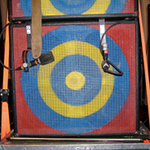Tristan Fitch and Sharon Ascher
Glacier
Rekover Projects
77 Franklin Street, Brooklyn, NY
October 3–November 16, 2014
Rekover Projects is pleased to present Glacier, a two-person exhibition of recent work by Tristan Fitch and Sharon Ascher.
The glacier is an absorbing metaphor for both artists, whose works focus on time, nature, and geology, among other things. Indeed, the very materials of their works’ existence—oil, cotton, and wood for Fitch, charcoal and paper for Ascher—come directly from the Earth, cultivated, extracted, and refined.
Like many abstract painters, Fitch is interested in process and materials, sensitive to duration and physicality. His large-scale paintings, which can take several months to complete, result from the repetitive layering of paint, first through underlying coats of uniform colors, then vigorous additions that are nearly exclusively applied with palette knives. Fitch occasionally smoothens the gruff ridges with a sander, so that they appear like serpentine veins under the skin. In other places he reworks the image by slashing the painting’s surface. While these gestures are forceful, they are neither violent nor aggressive. The chevron—the vertically repeated V-shapes traversing several paintings, looking like snake scales or a bony spine—harks back to ancient times. Perhaps not coincidentally, the shifting layers of a cracking glacier as they interact with solid rocks also produce this same pattern.
While a glacier is generally known for its solidity, the geological creation is constantly in flux and motion—which may not be detectable to the human eye. Such is the difference between seeing and knowing, which can be felt in Ascher’s five immense charcoal works on paper, about twenty feet tall apiece and suspended from the ceiling. Taken from her Reflection series and numbered 1 through 5, these elongated works embody an ephemeral, ineffable spirit, with surfaces that resemble marble or ash—accentuating the sublimation of a solid object directly into gas. The buoyancy in Ascher’s work reflects her other professional career as an innovative fabric and fashion designer: the charcoal markings resemble striations of glaciers and fabric elegantly folded and draped. At the same time, they evoke crinkled paper, cloud formations, and waves Ascher describes her work in this way: “Light and motion, stillness and silence, translucent layers of fabric floating gently in the breeze—an internal landscape of dreams and meditation made manifest in the world with color(s), texture and light.”
All kinds of details in Fitch’s and Ascher’s works—from lines and shapes to textures and patterns—reveal themselves in unexpected places. The viewer may wish to spend as much time eyeing their surfaces as the artists spent making them.
